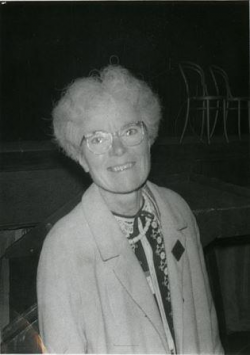Dame Kathleen Lonsdale

- Born
- 28 January 1903
- Died
- 1 April 1971 (age 68)
Dame Kathleen Lonsdale had a major influence on the development of X-ray crystallography and related fields in chemistry and physics. She was one of the first two women to be elected to the Royal Society and she was also a campaigner for prison reform.
As a child, Kathleen had to study the sciences at a boy’s school because her local girls’ school did not teach chemistry, physics or maths. She won a scholarship to Bedford College for Women and started to study maths, but changed to physics against the advice of her old headmistress who said it was a subject she would never distinguish herself in. In 1922, she graduated with the highest marks in physics that had been achieved for ten years.
Sir William Henry Bragg, a pioneer of X-ray diffraction, invited Dame Kathleen to join his research group at University College London, where she worked on the structure of simple organic crystals.
In 1927, she married Thomas Londsale and the couple moved to Leeds, where she worked at the University of Leeds’ Department of Physics. Using X-ray diffraction, she studied the structure of molecules. In 1929, she published a paper on the structure of the benzene ring in hexamethylbenzene. The publication of this paper had an enormous impact on organic chemistry. She also applied the Fourier method for the first time to analyse X-ray diffraction patterns to solve the structure of hexachlorobenzene.
Londsale was a Quaker and spent a month in prison after refusing to pay a fine when she did not register for war service. She managed to continue her scientific research while in prison. The time she spent there sparked her interest in prison reform which lasted for the rest of her life. She was an active campaigner, part of the Pugwash Movement, vice-president of the Atomic Scientist’s Association and president of the Women’s International League for Peace and Freedom.
Dame Kathleen Lonsdale played a fundamental role in establishing the science of crystallography and blazed a trail that many women scientists have since followed.
Dame Kathleen achieved a number of ‘firsts’. She was the first female professor at UCL, first female president of the International Union of Crystallography, and the first female president of the British Association for the Advancement of Science (BAAS, now the British Science Association). She helped to start the Young Scientist’s section of BAAS and was also an advocate for women playing a greater role in science. In 1945, she and Marjory Stephenson became the first two women to be elected as Fellows of the Royal Society.
Dame Kathleen also worked on the synthesis of diamonds and a form of diamond found only in meteorites, Lonsdaleite, was named after her. She was made a dame in 1956.



